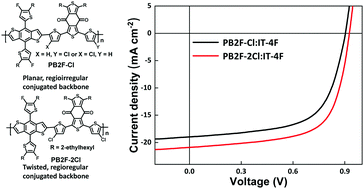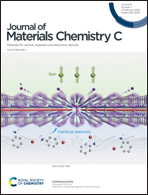Study of photovoltaic performances for asymmetrical and symmetrical chlorinated thiophene-bridge-based conjugated polymers†
Abstract
Two conjugated donor polymers (PB2F-Cl and PB2F-2Cl) based on benzo[1,2-b:4,5-b′]dithiophene and benzo[1,2-c:4,5-c′]dithiophene-4,8-dione with asymmetrical and symmetrical chlorinated thiophene-bridges were designed and synthesized. Both polymers exhibited extremely deep HOMO levels of −5.50 and −5.56 eV for PB2F-Cl and PB2F-2Cl, respectively. Although PB2F-Cl had a more planar conjugated backbone, PB2F-Cl exhibited a weaker aggregation behaviour than PB2F-2Cl in chlorobenzene solution due to its regioirregular conjugated backbone. After blending with an IT-4F acceptor, the PB2F-Cl:IT-4F film exhibited a slightly stronger lamellar stacking and a weaker π stacking compared to the PB2F-2Cl:IT-4F film as confirmed by grazing-incidence wide-angle X-ray scattering (GIWAXS) measurements. In PSCs, the power conversion efficiency (PCE) of the PB2F-Cl:IT-4F-based PSC was 10.81%, while the PCE of the PB2F-2Cl:IT-4F-based PSC reached 12.79%.



 Please wait while we load your content...
Please wait while we load your content...